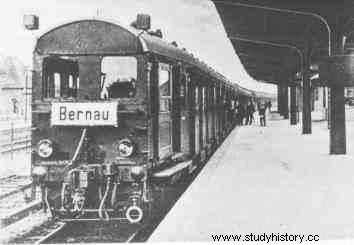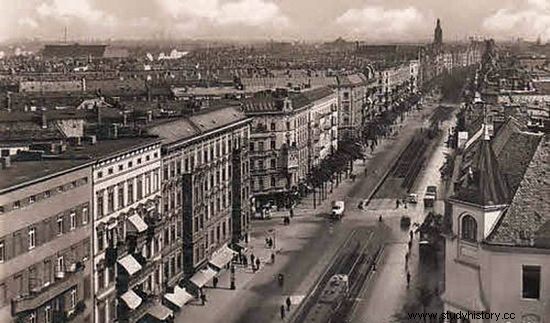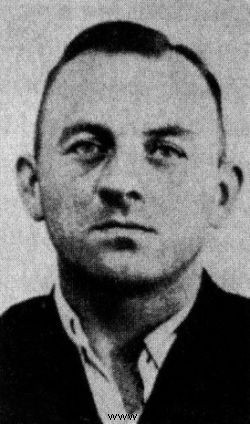With the German attack on Poland on September 1, 1939, a total blackout of the city was introduced in the capital of the Third Reich. The ordinance was supposed to protect Berlin from the effects of night raids, but it caused more harm than good. Road and rail fatalities have skyrocketed, and the Egyptian darkness has become a true criminals' paradise. Even a ... serial killer took advantage of the situation.
In the fall of 1940 - that is, shortly after the triumphant end of the German campaign in France - in Friedrichsfelde, in the eastern suburbs of Berlin, the body of a certain Gerda Ditter was found. A twenty-year-old mother of two was strangled and stabbed several times in the neck in her own home. The monstrous crime shook the city.
The shock was all the greater as some people quickly linked the gruesome crime to the events of the previous few months, when five other women were attacked in the same neighborhood. . Three of them were stabbed, one was beaten unconscious, and the last one was strangled and pushed from the S-Bahn train.

In such a setting, the Berlin degenerate felt like a fish in the water ... The photo shows the first Berlin S-Bahn train.
The S-Bahn killer
Initially, the Berlin police were helpless. The attacks were carried out at night, and due to the total blackout of the city, no one was able to give any description of the suspect. In this situation, the investigators had no choice but to wait for the next move of the degenerate. It took place after a month - on November 4th to be exact.
This time the victim was a thirty-year-old woman on a train to Köpenick - the southernmost part of Berlin. An anonymous psychopath hit her on the head and threw her out of the speeding wagon . Despite these "efforts", the passenger survived and testified that the perpetrator was wearing the uniform of a railwayman. Additionally, investigators found a murder weapon in a nearby car:a lead tube.
All this, however, was not enough to find the wanted man, who attacked again after another month. On December 4, two new victims of the sinister railwayman appeared. The first was nineteen-year-old Irmgard Frese, who was found unconscious early in the morning near the Karlshorst railroad tracks. She was hit on the head with a blunt instrument and then raped .

At the turn of 1940 and 1941, the inhabitants of Berlin were much more afraid of the marauding psychopath than of the Allied raids.
The woman was taken to hospital, but she died after a few hours without regaining consciousness. The ink in the police crime scene report had not yet dried up well, when only 500 meters away another corpse . Twenty-six-year-old nurse Elfriede Frank lay by the railroad tracks in Rummelsburg. Like one of her previous victims, she was thrown from the train and her skull fractured as a result.
With the Berlin investigators, the ground was slowly burning underfoot, and the perpetrator seemed elusive, leaving only more bodies behind. He struck twice more in December.
Two days before Christmas Eve, the body of thirty-year-old Elisabeth Büngener was found near the tracks in Rahnsdorf, and a week later the psychopath targeted Gertrud Siewert, whose body was discovered near the rails in Karlshorst.
After another seven days on January 5, 1941, another victim appeared :Hedwig Ebau, twenty-eight, was found dead near Wuhlheide.
Despite the efforts of the authorities, doing everything to silence the whole matter, Berlin was just buzzing with gossip. The capital's tabloid press, which hailed the wanted "S-Bahn murderer", played a significant role in fueling widespread psychosis. To make matters worse, the work of the police was hampered by the fact that due to the mass extinction of lights, death on the railroad became a common phenomenon.
In December 1940 alone, as many as 28 fatal accidents were recorded on Berlin trains, 25 of which were directly caused by the blackout. As a result, it was often difficult to distinguish victims of a mishap or suicide from the unfortunates who got in the way of a serial killer.

Map of the districts of Berlin where the murderer was prowling with the locations of his attacks marked.
A spy, a Jew or a forced laborer?
The black streak of killings became the perfect breeding ground for speculation about who the mysterious "S-Bahn killer" was. Some believed that he was a Jew, while others saw his activities as the hand of British intelligence. The Kripo (criminal police) had their own theories and focused on two groups:slave laborers and railroad workers.
The first group caught the attention of the officers, because in the area where the murders were carried out, many workers from outside the Reich, employed, among others, at plants belonging to Deutsche Bahn.
In turn, the testimonies of the witnesses pointed to the railwayman, and therefore the investigators analyzed the changes and working hours of over 5,000 railway workers, hoping that this Sisyphean work would indicate a potential case. There was also a high award - 10,000 reichsmark - for information that could help in his capture. Finally, prevention was not forgotten.

Kripo badge. It was her officers who were looking for the S-Bahn murderers.
More patrols appeared at the stations and platforms, and Kripo officers dressed in female costumes tried to provoke the degenerate into an attack. However, this method did not bring the desired results, and therefore policewomen joined the action. Interestingly, they were not equipped with any weapons, and their only protection in the event of an attack was to use reinforced headgear!
The measures taken have had some results. As Roger Moorhouse, author of Hitler's Capital. Life and death in Berlin during the war ”, did not lead to the arrest of the perpetrator, but at least they could have caused him fear.

Paul Ogorzow. The S-Bahn killer himself.
Perhaps that is why there was no new victim in January. The criminal returned only after five weeks of peace. On February 11, the body of thirty-nine-year-old Johanne Voigt was found near the tracks in Rummelsburg.
After committing this crime, the murderer fell underground for several months. It made itself known again at the beginning of July. As if deliberately confusing the constables, this time he did not attack on the train, but returned to the methods from the beginning of his murderous "career".
His - as it turned out - the last victim was Frieda Koziol, found on July 3. The degenerate committed a crime in Friedrichsfelde, where the first unfortunate woman died ten months ago.
However, this time the Kripo officers were more fortunate. The perpetrator left evidence in the form of a shoe print at the crime scene. In addition, the results were brought by the painstaking analysis of the schedules of railway employees, as a result of which eight suspects were selected.
Among them was the twenty-nine-year-old deputy signalman Paul Ogorzow. He had been interrogated before, but as a member of the NSDAP and SA he did not raise any major suspicions. Nevertheless, during the ongoing operational activities, his name kept coming back and so it was finally decided to take a closer look at him.
His friends unequivocally described him as a woman hating woman, and one of his colleagues testified that he saw Ogorzov, during his service, jump over the railroad fence and disappear into the darkness.
It was the Jewish doctor's fault

The investigators needed nothing more. On July 12, Paul Ogorzow was arrested, where he was subjected to intense interrogation. At the same time, his alibi was carefully checked, the results of a forensic examination were collected and the footprints were compared.
Eventually, after six days, the suspect burst open, pleading guilty to eight homicides, six attempted murders, and thirty-one other sexual assaults .
After pleading guilty, the criminal took a peculiar line of defense. Namely, he maintained that the cause of his behavior was ... an unconventional treatment for gonorrhea prescribed by a Jewish doctor. However, even in Hitler-ruled Germany it did not help him.
Investigators did not believe in the "politically correct" justification, assessing Ogorzow in his final report as a man cold and calculating, with steely nerves and uninhibited when it came to satisfying his sex drive.
The court also did not believe the murderer's explanations and sentenced him to death. The sentence was carried out at express pace and on July 25, the "S-Bahn killer" was guillotined at Plötzensee prison.
Source:
- Roger Moorhouse, Hitler's capital city. Life and Death in wartime Berlin , Znak, 2011 (more information on the publisher's website).
